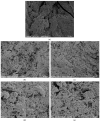Minced Beef Meat Paste Characteristics: Gel Properties, Water Distribution, and Microstructures Regulated by Medium Molecular Mass of γ-Poly-Glutamic Acid
- PMID: 38397487
- PMCID: PMC10887638
- DOI: 10.3390/foods13040510
Minced Beef Meat Paste Characteristics: Gel Properties, Water Distribution, and Microstructures Regulated by Medium Molecular Mass of γ-Poly-Glutamic Acid
Abstract
The influences of various m-γ-PGA (0.08-0.20%, w/w) concentrations on the properties of minced beef meat paste in terms of rheological properties, texture, moisture distribution, and microstructures were evaluated. The results indicated that m-γ-PGA enhanced the water-holding capacity, gel strength, texture, and whiteness of the minced beef meat paste. Based on the microstructural results, m-γ-PGA helped form a more organized and compact gel, thereby limiting the migration of water through the gel matrix. In contrast to the control group, the water-holding property, gel strength, and whiteness of minced meat paste gels with m-γ-PGA content of 0.12% increased from 75.89%, 584.51 g·cm, and 61.83 to 79.91%, 780.87 g·cm, and 62.54, respectively (p < 0.05), exhibiting the highest water-holding property and gel strength. Thus, m-γ-PGA exhibits great potential for minced meat paste products as a healthy gel water retainer and enhancer in low-fat meat products.
Keywords: gel property; microstructure; minced beef meat paste; molecular weight; water-holding capacity; γ-poly-glutamic acid.
Conflict of interest statement
The authors declare no conflicts of interest.
Figures







Similar articles
-
Effect of poly-γ-glutamic acid on hydration and structure of wheat gluten.J Food Sci. 2020 Oct;85(10):3214-3219. doi: 10.1111/1750-3841.15400. Epub 2020 Aug 28. J Food Sci. 2020. PMID: 32857865
-
Effect of oil-modified crosslinked starch as a new fat replacer on gel properties, water distribution, and microstructures of pork meat batter.Food Chem. 2023 May 30;409:135337. doi: 10.1016/j.foodchem.2022.135337. Epub 2022 Dec 28. Food Chem. 2023. PMID: 36587514
-
The dual role of mannosylerythritol lipid-A: Improving gelling property and exerting antibacterial activity in chicken and beef gel.Food Chem. 2025 Feb 1;464(Pt 3):141835. doi: 10.1016/j.foodchem.2024.141835. Epub 2024 Oct 30. Food Chem. 2025. PMID: 39504896
-
γ-PGA and MTGase improve the formation of ε-(γ-glutamyl) lysine cross-links within hairtail (Trichiurus haumela) surimi protein.Food Chem. 2018 Mar 1;242:330-337. doi: 10.1016/j.foodchem.2017.08.087. Epub 2017 Aug 30. Food Chem. 2018. PMID: 29037697
-
Engineering processes in meat products and how they influence their biophysical properties.Meat Sci. 2013 Dec;95(4):871-8. doi: 10.1016/j.meatsci.2013.04.053. Epub 2013 Apr 29. Meat Sci. 2013. PMID: 23702340 Review.
Cited by
-
Effect of Using Oleogel on the Physicochemical Properties, Sensory Characteristics, and Fatty Acid Composition of Meat Patties.Foods. 2024 Nov 28;13(23):3849. doi: 10.3390/foods13233849. Foods. 2024. PMID: 39682921 Free PMC article.
-
Enhanced Poly-γ-Glutamic Acid Production by a Newly Isolated Bacillus halotolerans F29.J Microbiol. 2024 Aug;62(8):695-707. doi: 10.1007/s12275-024-00153-w. Epub 2024 Aug 20. J Microbiol. 2024. PMID: 39164498
-
Gel Properties and Protein Structures of Minced Pork Prepared with κ-Carrageenan and Non-Meat Proteins.Gels. 2024 Apr 30;10(5):305. doi: 10.3390/gels10050305. Gels. 2024. PMID: 38786222 Free PMC article.
References
-
- Hawley A.L., Liang X., Børsheim E., Wolfe R.R., Salisbury L., Hendy E., Wu H., Walker S., Tacinelli A.M., Baum J.I. The potential role of beef and nutrients found in beef on outcomes of wellbeing in healthy adults 50 years of age and older: A systematic review of randomized controlled trials. Meat Sci. 2022;189:108830. doi: 10.1016/j.meatsci.2022.108830. - DOI - PubMed
-
- Van Wezemael L., Caputo V., Nayga R.M., Chryssochoidis G., Verbeke W. European consumer preferences for beef with nutrition and health claims: A multi-country investigation using discrete choice experiments. Food Policy. 2014;44:167–176. doi: 10.1016/j.foodpol.2013.11.006. - DOI
-
- Du J., Zhou C., Xia Q., Wang Y., Geng F., He J., Sun Y., Pan D., Cao J. The effect of fibrin on rheological behavior, gelling properties and microstructure of myofibrillar proteins. LWT. 2022;153:112457. doi: 10.1016/j.lwt.2021.112457. - DOI
Grants and funding
LinkOut - more resources
Full Text Sources

